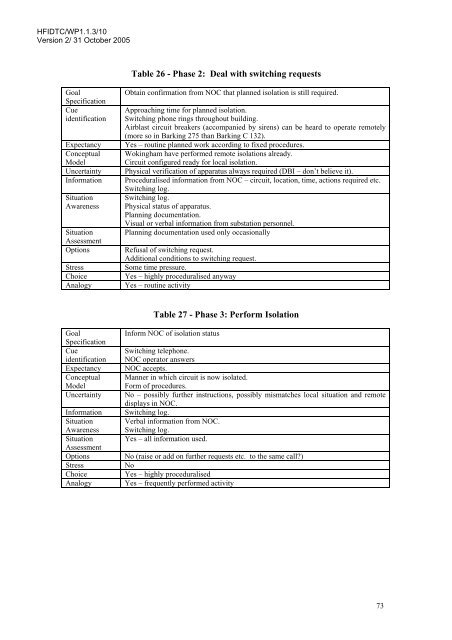A Review of the Event Analysis of Systemic Teamwork Methodology
A Review of the Event Analysis of Systemic Teamwork Methodology
A Review of the Event Analysis of Systemic Teamwork Methodology
- No tags were found...
Create successful ePaper yourself
Turn your PDF publications into a flip-book with our unique Google optimized e-Paper software.
HFIDTC/WP1.1.3/10<br />
Version 2/ 31 October 2005<br />
Table 26 - Phase 2: Deal with switching requests<br />
Goal<br />
Specification<br />
Cue<br />
identification<br />
Expectancy<br />
Conceptual<br />
Model<br />
Uncertainty<br />
Information<br />
Situation<br />
Awareness<br />
Situation<br />
Assessment<br />
Options<br />
Stress<br />
Choice<br />
Analogy<br />
Obtain confirmation from NOC that planned isolation is still required.<br />
Approaching time for planned isolation.<br />
Switching phone rings throughout building.<br />
Airblast circuit breakers (accompanied by sirens) can be heard to operate remotely<br />
(more so in Barking 275 than Barking C 132).<br />
Yes – routine planned work according to fixed procedures.<br />
Wokingham have performed remote isolations already.<br />
Circuit configured ready for local isolation.<br />
Physical verification <strong>of</strong> apparatus always required (DBI – don’t believe it).<br />
Proceduralised information from NOC – circuit, location, time, actions required etc.<br />
Switching log.<br />
Switching log.<br />
Physical status <strong>of</strong> apparatus.<br />
Planning documentation.<br />
Visual or verbal information from substation personnel.<br />
Planning documentation used only occasionally<br />
Refusal <strong>of</strong> switching request.<br />
Additional conditions to switching request.<br />
Some time pressure.<br />
Yes – highly proceduralised anyway<br />
Yes – routine activity<br />
Table 27 - Phase 3: Perform Isolation<br />
Goal<br />
Specification<br />
Cue<br />
identification<br />
Expectancy<br />
Conceptual<br />
Model<br />
Uncertainty<br />
Information<br />
Situation<br />
Awareness<br />
Situation<br />
Assessment<br />
Options<br />
Stress<br />
Choice<br />
Analogy<br />
Inform NOC <strong>of</strong> isolation status<br />
Switching telephone.<br />
NOC operator answers<br />
NOC accepts.<br />
Manner in which circuit is now isolated.<br />
Form <strong>of</strong> procedures.<br />
No – possibly fur<strong>the</strong>r instructions, possibly mismatches local situation and remote<br />
displays in NOC.<br />
Switching log.<br />
Verbal information from NOC.<br />
Switching log.<br />
Yes – all information used.<br />
No (raise or add on fur<strong>the</strong>r requests etc. to <strong>the</strong> same call)<br />
No<br />
Yes – highly proceduralised<br />
Yes – frequently performed activity<br />
73
















